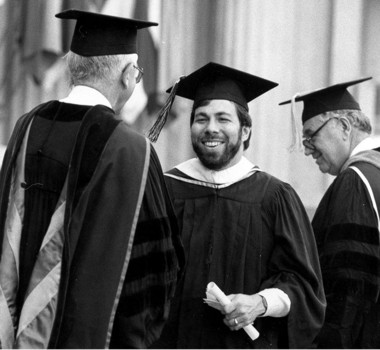| Steve Wozniak - Electronics Genius |
| Written by Harry Fairhead | ||||||
Page 2 of 2
The S100 modular machines of the time were just beginning to use colour displays but they were expensive. Woz had designed a seven chip colour circuit that would work with a colour TV. He knew that domestic TVs were very sloppy in terms of their timing so he managed to produce a very low chip count 40 character display that didn't quite meet the TV standards specification but would work in most cases. Not many professional electronics designers at the time would have thought to cut corners in this way. He also cheated on the addressing for the memory mapped graphics to save two chips at the cost of a strangely mangled memory layout. For years to come users of the Apple II would wonder why memory adjacent memory locations didn't always control adjacent screen locations. A similar trick but this time adding two chips allowed him to shift out the memory locations directly into the video generator and so produce high resolution colour graphics. If you're impressed by the attention to detail the amazing fact is that Woz also wrote the system software including Apple Integer Basic - yes that's right they didn't need Bill Gates and Microsoft. Even the prototype Apple II was impressive but Woz still wasn't happy. He wanted to play breakout, the game he had implemented for Atari - so he added a pair of game paddles. The standard way of doing this at the time was to use an AtoD converter for the x axis and one for the y axis. A pair of variable resistors where then used in a complex mechanical joystick arrangement. The computer worked out where the joysticks were positioned by reading the resistance values using the AtoD converters. How did Woz do the job? No he didn't bother with an AtoD converter, that would have been expensive. Instead he used a chip containing four (555) timers and used the paddles to control the width of the pulse that they produced - a habit that the IBM PC was to catch some years later. With this addition breakout was not only possible but relatively easy using BASIC. When enthusiasts were shown the machine they were more than impressed - they wanted one. While other machines costing more were simply displaying characters on monochrome VDUs or on simple LED displays the Apple II had full color graphics and you could play games on it like Pong! An odd feature of the design was the provision of expansion slots. These looked superficially like a bus but instead each slot had a pre-decoded memory location and the ability to include a 256Byte PROM and a 2KByte memory space. This allowed Apple II expansion cards to be simple because they didn't need to include their own memory decoding. This wasn't a completely new feature, for example the South West Technical Products (SWTP) 6800 machine used the same idea, but it helped make the Apple II great.
Apple II complete with disk drives - photo by Rama A Lasting DesignAlthough the Apple II was an excellent design, I personally think that Woz reached a new height in the design of the Apple II disk drive. Every other manufacturer was building machines based on complex read/write electronics on the disk drive and then even more complex disk controllers in the machine. Woz didn't really know how disk drives were supposed to work and so he invented his own way of doing things. He started with a disk drive with virtually no electronics and then implemented an integrated controller and read/write electronics. The bulk of the work though was done in software and this simplified the electronics to an extent that, at the time, was difficult to believe. The Woz disk drive must have made a great deal of money for Apple because it cost next to nothing to make but sold for the price that users expected to pay for a disk drive! The Woz design was so clever that it lived on in and improved form in the Mac. The IWM, the Integrated Woz Machine, was a custom chip implementation of the same ideas. Woz as "Rocky Clark"In 1981 Woz was involved in a plane crash. He suffered head injuries and lost his ability to form new long term memories. He went to parties, escaped from hospital, played computer games and couldn't remember any of it. He eventually recovered but didn't go back to working at Apple. The accident was more an excuse than a reason for leaving Apple. By this time the managers had taken over and Woz was only a humble engineer. He left Apple and decided to go back to school! He enrolled at Berkeley again using an assumed name - Rocky Clark. Obviously a man a talented as Woz couldn't take the inanities of his lecturers without an argument - but who was "Rocky Clark" to tell them how to do it properly! He returned to Apple at the end of the year but, apart from writing and giving away a spreadsheet that would have challenged VisiCalc if Apple hadn't killed it, he didn't do very much that was important. Back in the early days Woz could do magic things by saving a few chips and building really clever electronics. As the ability to integrate more into a single chip grew no one cared about clever design or saving components. This is the hardware analogy of the clever code that Bill Gates excelled at in the early days.You could look at a Woz design and spend hours wondering what any given component was doing - the answer was that it usually was doing more than one job! The growth in the power of hardware, mainly the low cost of large amounts of memory, removed the need for that skill as well! Only one other designer has shown the same skills as Woz and that's Clive Sinclair. The age of the clever elegant economical design, be it hardware or software, seems long gone. For an account of other aspects of Woz's life see his 2006 autobiography, iWoz:From Computer Geek to Cult Icon: How I invented the Personal Computer, Founded Apple and Had Fun Doing It, co-authored with journalist Gina Smith. Fame and RecognitionIn 2015, the year in which Woz turned 65 he was selected by public vote to be the next Tech Pioneer to be cast as a waxwork by Madame Tussauds. Once his statue is complete, it will be on display next to Steve Jobs and Mark Zuckerberg in San Francisco. This recognition adds to an impressive list of honors which includes the ACM Grace Murray Hopper Award in 1979, and the National Medal of Technology, jointly with Steve Jobs, presented by President Ronald Reagan in 1985. In 1997, he became a Fellow of the Computer History Museum "for co-founding Apple Computer and inventing the Apple I personal computer" and was inducted into the Inventors Hall of Fame in 2000. In 2011 the received the Global Award of the President of Armenia for Outstanding Contribution to Humanity through IT and in 2014 was presented with the 66th Hoover Medal for his professional achievements and personal endeavors that have advanced the well-being of humankind. In 1986, Woz finished his degree in electrical engineering at the University of California in Berkeley, graduating using the name Rocky Raccoon Clark to keep his identity secret. He had originally enrolled in Berkeley in 1971, but as he told the Los Angeles Times: "I simply took a year off to earn money for my fourth year of school. And then my career kept going up."
Woz also has multiple Honorary Doctor of Engineering degrees from universities around the world and in 2015 became the University of California's Alumni Association's Alumnus of the Year, honored for "his invaluable contributions to education and to UC Berkeley". Since 2014 he has been an adjunct professor at the University of Technology in Sydney, communicating with students in the school's Magic Lab via video chat. Having applied for Australian citizenship and is in the process of moving there.
Related ArticlesSteve Jobs and the Early Apple Years Clive Sinclair And The Small Home Computer Revolution Apple 1 Sold For Record Price of $668K Milestones in the history of Apple Woz and Jobs - The Blue Box Days
Comments
or email your comment to: comments@i-programmer.info
<ASIN:0471720836> <ASIN:1593270100>
|
||||||
| Last Updated ( Friday, 15 August 2025 ) |




